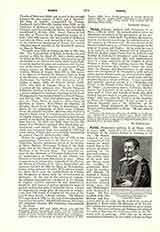

Vanni, ANDREA, painter and statesman, b. at Siena, 1320; d. 1414. He entered politics after the democratic overthrow of the government of the city. A letter written to him by St. Catherine, his country-woman and friend, concerning the administration of the country, is still preserved. He was elected to the Grand Council and sent as Sienese ambassador to the pope at Avignon and Naples. As an artist he was a weak imitator of Simone Martini and of Lorenzetti.
With his brother Lippo Vanni, Bartolo di Fredi, and Taddeo di Bartolo, he introduced early Sienese art into the fifteenth century. His chief authenticated work is a large polyptych in the Church of Santo Stefano at Siena. This painting depicts the Virgin enthroned between Sts. Stephen, James the Less, John the Baptist, and Bartholomew; in the niches above are the figures of the Evangelists, while several saints and an Annunciation are painted in five higher projecting compartments. The small heads and the gestures betray a certain stiffness. A very agreeable and carefully painted picture is a “Madonna and Child” in the Church of San Michele. A “Birth of the Virgin”, representing James, Catherine, Bartholomew, and Elizabeth, in the gallery at Siena, is the joint work of Vanni and Bartolo di Fredi, who often worked together both in art and politics. A “Crucifixion” with two saints by Vanni is in the Academy at Siena, an “Annunciation” in two panels in the Palazzo Saraceni, and a “St. Sebastian” at the museum. Vanni celebrated St. Catherine in the frescoes of San Domenico at Siena. He also painted at Naples.
G. GIETMANN

